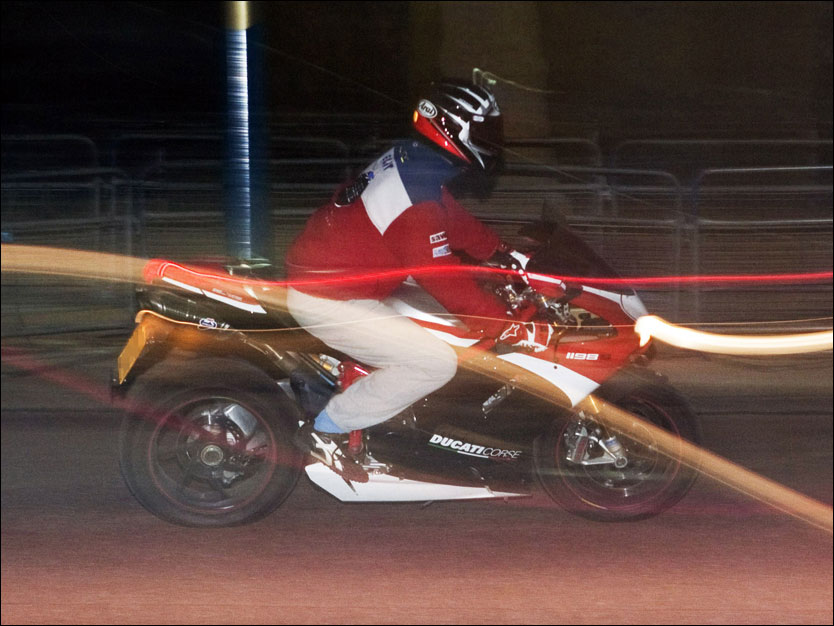The best man for the job is rarely the easiest to find.
by Patrick Symmes
It took me 10 years to find just the right guy.
I had a work of art ? a CB400F Super Sport, one of the light Honda motorcycles from the 1970s that was a game-changing classic. But I needed the right mechanic ? someone to put the honey back into a half-disassembled, 35-year-old hulk rusting in the back of my mom?s New Hampshire garage. I felt like an absentee father. I knew the bike was tarnishing from neglect, but you shouldn?t trust a family heirloom to just anyone.
After a decade of inquiry and sporadic investigation, of napkin-written notes left on strangers? seats, I finally found Hidetaka Takasaki, a Japan-born mechanic in Queens who refuses to let gorgeous old machines die. Taka inhaled sharply when I told him what I was sending his way: my dad?s old Super Sport, a surprisingly swift, agile bike from 1975. These ?small four? bikes were the tools that led Honda?s takeover of the American market in two wheels. Minimalist and elegant in the Japanese way, the Super Sports had high-tech innovations (a disc brake, electric starters) at everyman prices. The engineering ? four tightly tuned cylinders ? let them explode past much bigger British bikes on twisty racecourses. And the light handling and four-into-one exhaust system suddenly made the not-so-easy-riding choppers of the 1960s look and sound like blunderbusses.
?Oh,? the master mechanic moaned. His English was cryptic, Yoda-like. He spoke with awe of the four-stroke bike?s famously seductive sound, like a lioness growling. ?Very good bike,? he said. ?I do you special.?
?
I remember my dad picking up the slightly used Honda cheap around 1979. The red paint still gleamed, and he looked cool when he left for work every morning. A few years later, he was giving me deadly serious lessons on the Honda, months of skill-building in church parking lots and back lanes before he let me go as far as the store. Fluency in shifting, unthinking access to the controls, easy balance, and constant fear ? those are the tools for staying alive on two wheels.
At the tail end of that summer, I was permitted to ride it to a high school dance. When I strode into the gym that night, 17 with a helmet tucked conspicuously under my arm, life changed forever. In college I dragged a peg for the first time, the leaned-over rite of initiation that left a scrape on the left footrest (still visible, thank you). I rode it to my first newspaper job and on my first long jaunts around New England, training for the rides I would make later, like crossing South America on a big BMW.
But eventually the carbs began to leak, my rides became rare, and around 1995 I coasted the Honda into my mom?s garage, promising to retrieve it the next year. And then the next. And the next. One local mechanic disassembled the carbs; five years later, another put them back together. Still, I was nowhere.
Year after guilty year, I questioned Manhattan bikers whose old Hondas gleamed like new. And every time, the answer came back the same. From a guy climbing onto a green 350 Super Sport in front of the Parsons School of Design: ?There?s some Japanese guy in Queens.? Years later, eyeing a sweet black-and-red Super Sport in front of the Ear Inn, where poseur bikers sometimes gather, I got a little closer: the same Japanese guy. Somewhere in Astoria. He was impossible to reach, no one knew his name, his website was wrong, his phone didn?t work.
Finally the Honda?s steady accumulation of rust guilted me into tucking notes under the seat straps of any decent old Japanese bike I saw around town. A year ago, after leaving my business card on a handsome CB500 in Greenwich Village, I got a hit ? by return e-mail, a four-letter name and a phone number in Astoria.
Taka didn?t blush when he saw the peeling paint, the lame handlebars my dad had added, or my crazy wiring experiments from 1985. He just nodded. ?Most beautiful,? he said. English isn?t Taka?s strong point ? we think safety the first, it says on his website, peak-point.net ? but his Japanese lets him cruise home-country listings and fan forums for tips, like where to find the original flat handlebars I wanted. Taka has been fixing internal combustion engines since his grandfather gave him a leaf-blower engine when he was eight, he said, and he felt an almost religious obligation to keep machines like my Honda alive.
The cult of the old motorcycles evokes wabi-sabi ? the Japanese love of well-worn, beautiful things ? but that?s just American for being useful and beloved at the same time. Simple, cheap, and elegant, old Hondas like mine are likely to endure for decades to come, even as the trendy crotch-rockets melt down into their plastic parts.
I?ve changed since the ?70s, and so has motorcycling. There are more cars moving faster, and fewer helmet laws. My own ambitions are fittingly modest for a machine with 1970s brakes and a man with a 1970s ***.
Taka?s rebuilds can be found all over New York now, along with the thousands of other old racehorses that good mechanics have saved from America?s deadly garage-tombs. The cafe-racer clan gathers ? with other tribes ? for rallies in Williamsburg, Brooklyn, that Taka organizes, where we mostly stand around ogling the sweet machines. And congratulate ourselves on finding Taka.



